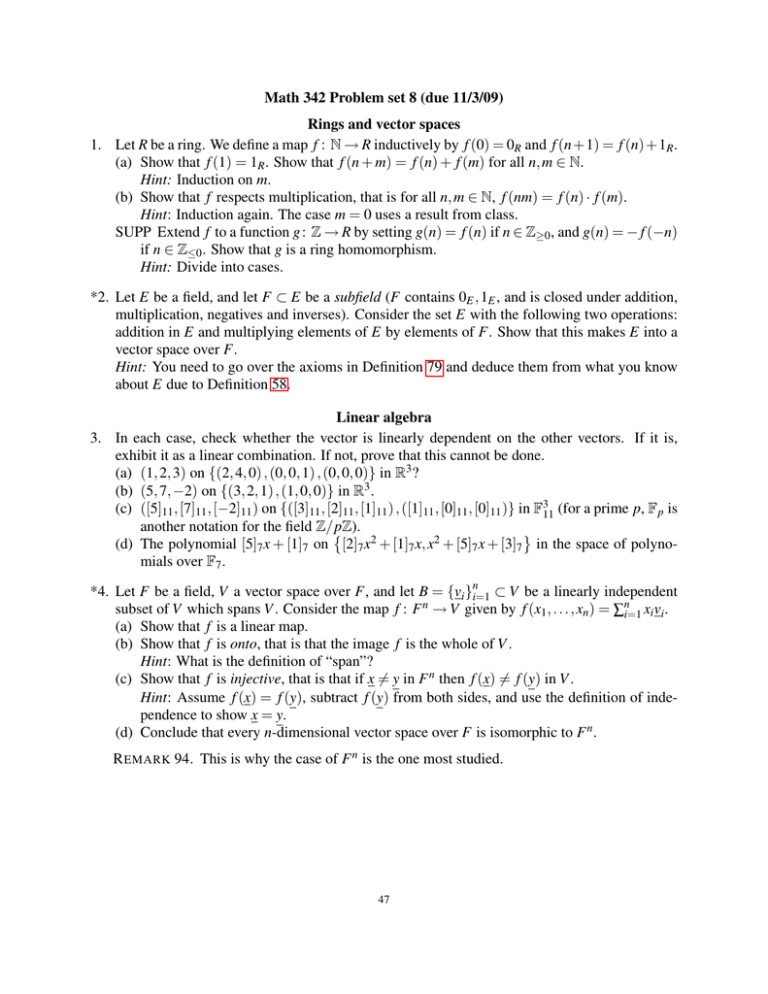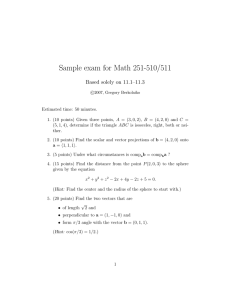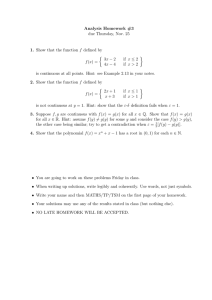Math 342 Problem set 8 (due 11/3/09) Rings and vector spaces 1.
advertisement

Math 342 Problem set 8 (due 11/3/09)
Rings and vector spaces
1. Let R be a ring. We define a map f : N → R inductively by f (0) = 0R and f (n+1) = f (n)+1R .
(a) Show that f (1) = 1R . Show that f (n + m) = f (n) + f (m) for all n, m ∈ N.
Hint: Induction on m.
(b) Show that f respects multiplication, that is for all n, m ∈ N, f (nm) = f (n) · f (m).
Hint: Induction again. The case m = 0 uses a result from class.
SUPP Extend f to a function g : Z → R by setting g(n) = f (n) if n ∈ Z≥0 , and g(n) = − f (−n)
if n ∈ Z≤0 . Show that g is a ring homomorphism.
Hint: Divide into cases.
*2. Let E be a field, and let F ⊂ E be a subfield (F contains 0E , 1E , and is closed under addition,
multiplication, negatives and inverses). Consider the set E with the following two operations:
addition in E and multiplying elements of E by elements of F. Show that this makes E into a
vector space over F.
Hint: You need to go over the axioms in Definition 79 and deduce them from what you know
about E due to Definition 58.
Linear algebra
3. In each case, check whether the vector is linearly dependent on the other vectors. If it is,
exhibit it as a linear combination. If not, prove that this cannot be done.
(a) (1, 2, 3) on {(2, 4, 0) , (0, 0, 1) , (0, 0, 0)} in R3 ?
(b) (5, 7, −2) on {(3, 2, 1) , (1, 0, 0)} in R3 .
(c) ([5]11 , [7]11 , [−2]11 ) on {([3]11 , [2]11 , [1]11 ) , ([1]11 , [0]11 , [0]11 )} in F311 (for a prime p, F p is
another notation for the field Z/pZ).
(d) The polynomial [5]7 x + [1]7 on [2]7 x2 + [1]7 x, x2 + [5]7 x + [3]7 in the space of polynomials over F7 .
*4. Let F be a field, V a vector space over F, and let B = {vi }ni=1 ⊂ V be a linearly independent
subset of V which spans V . Consider the map f : F n → V given by f (x1 , . . . , xn ) = ∑ni=1 xi vi .
(a) Show that f is a linear map.
(b) Show that f is onto, that is that the image f is the whole of V .
Hint: What is the definition of “span”?
(c) Show that f is injective, that is that if x 6= y in F n then f (x) 6= f (y) in V .
Hint: Assume f (x) = f (y), subtract f (y) from both sides, and use the definition of independence to show x = y.
(d) Conclude that every n-dimensional vector space over F is isomorphic to F n .
R EMARK 94. This is why the case of F n is the one most studied.
47
The Hamming Code (variant)
5. Let H ∈ M3×7 (F2 ) be the matrix whose columns are all non-zero vectors in F32 , that is
1 0 0 1 1 0 1
H = 0 1 0 1 0 1 1 .
0 0 1 0 1 1 1
(a) Let a, b, c, d ∈ F2 be a 4-bit “message” we want to transmit. Show that there exist unique
x, y, z ∈ F2 so that H · (x, y, z, a, b, c, d)T = 0. We will trasmit the redundant 7-bit vector
instead.
Hint: Need to show both that x, y, z exist and that they are unique. Express the problem as
a system of linear equations over F2 .
(b) For each 1 ≤ i ≤ 7, let ei be the standard basis vector of F72 with 1 at the ith co-ordinate.
Calculate the seven vectors Hei .
(c) Let v, v0 ∈ F72 be at Hamming distance 1. Show that there exists i so that v0 = v + ei .
(d) Now let’s say Alice transmits the 7-bit vector v = (x, y, z, a, b, c, d)T from part (a), through
a channel that can change at most one bit in every seven. Denote by v0 the 7 bits Bob
receives, and show that if v0 6= v then Hv0 6= 0. Conclude that Bob can detect if a 1-bit
error occured.
Hint: Use the fact that Hv = 0 and your answers to parts (c) and (b).
(e) In fact, if at most one bit error can occur then Bob can correct the error. Using the fact
that the vectors Hei are all different (see your answer to part (b)), show that knowing only
v0 and that at most one error occured, he can calculate the difference e = v0 − v and hence
the original vector v.
Hint: What are the possibilities for e? For He? how do they match up? Don’t forget that
it’s possible that v0 = v.
Supplementary problems
A (Prime fields and finite fields)
(a) Let g be the map from 1(c). Show that Ker(g) is an ideal of Z.
(b) Let E be a field, and let g : Z → E be the map from problem 1. Show that Ker(g) = (p)
where p = 0 or p is prime.
Hint: If m = ab apply g to both sides.
(c) Conclude that every finite field contains a copy of F p ' Z/pZ for a prime p.
(d) Show that every finite field has pn elements for some n.
R EMARK . It is also true that for every q = pn there exists a field Fq of size q, unique up to
isomorphism.
48

